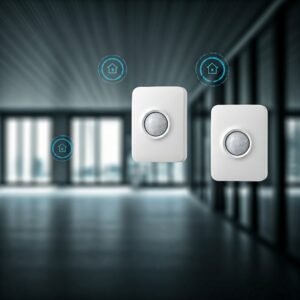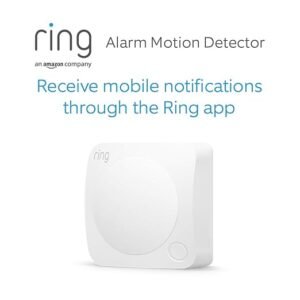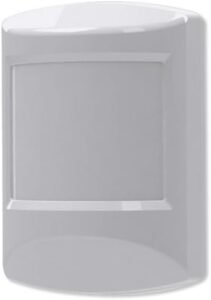Introduction

Smart motion sensors are becoming an essential part of modern smart home automation, enhancing both security and convenience. These smart devices detect movement and trigger automated actions, such as turning on lights or adjusting thermostats, making your home more responsive to your needs. Smart motion sensor lights are particularly popular for their ability to automatically illuminate a room when motion is detected, saving energy and improving convenience. Additionally, outdoor smart movement sensors provide an added layer of security by monitoring your yard or entryways for any unusual movement.
In this article, we’ll explain how smart motion sensors work, their benefits, and explore various use cases for both indoor and outdoor settings. We’ll also review some of the best smart motion sensor lights and outdoor smart motion sensors available to help you choose the right products for your home automation system.
What Are Smart Motion Sensors?
Smart motion sensors are devices designed to detect movement within a specific area and trigger an action in response. They use technologies like infrared (PIR) or ultrasonic sensors to detect changes in heat or sound waves when a person or object moves. These sensors are often integrated into home automation systems, allowing them to control devices like lights, thermostats, and security systems based on motion.
Although there are many use cases for smart motion sensors in home automation, as we’ll explore later in this article, one common use is the activation of smart motion sensor lights to automatically turn on when motion is detected, making your home more energy-efficient and convenient. Similarly, outdoor smart movement sensors monitor the exterior of your home, enhancing security by detecting movement around entryways, driveways, or gardens.
By automating tasks based on detected motion, these smart motion detectors enhance security, improve energy efficiency, and elevate the overall convenience and lifestyle of your smart home setup.
Key Benefits of Smart Motion Sensors
Smart motion sensors offer several key benefits that make them a valuable addition to any smart home system. These sensors can improve security, enhance energy efficiency, and elevate overall convenience, helping you save time and effort while boosting your home’s functionality.
- Enhanced Security: One of the primary advantages of smart motion sensors is their ability to improve home security. Outdoor smart motion sensors can monitor the perimeter of your home, detecting movement in areas like driveways, gardens, and entryways. They can trigger lights or cameras, alerting you to potential intruders or unusual activity. Indoors, smart motion detectors can be integrated with security systems to provide an extra layer of protection by triggering alarms or notifying homeowners of unexpected movement.
- Energy Efficiency: Smart motion sensor lights are a great way to reduce energy consumption. The lights only turn on when motion is detected, meaning you’re not wasting electricity in empty rooms or hallways. In addition to lighting, motion sensors can also work with thermostats and HVAC systems to optimize energy use by adjusting the temperature based on room occupancy. This contributes to overall energy savings, lowering utility bills and promoting sustainability.
- Convenience and Automation: Perhaps one of the greatest benefits of smart motion sensors is the convenience they offer. By automating everyday tasks in combination with other smart home devices, such as turning lights on when entering a room, adjusting temperature settings when you arrive home or open blinds automatically based on schedules and day light, these sensors remove the need for manual intervention. This level of automation not only saves time but also enhances your lifestyle by creating a hands-free environment.
- Integration with Other Smart Devices: Smart motion sensors are designed to integrate easily with a variety of other smart devices. Whether it’s controlling smart lights, adjusting your thermostat, or enhancing your security system, motion sensors can be programmed to trigger actions across your entire smart home setup. This compatibility creates a cohesive system that works together, making your home more efficient and responsive.

Top Use Cases for Smart Motion Sensors in Home Automation
Smart motion sensors can be used in a wide range of home automation scenarios to improve convenience, security, and energy efficiency. Here are some of the top use cases:
- Lighting Automation: One of the most popular uses for smart motion sensors is lighting control. These sensors can automatically turn on smart motion sensor lights when you enter a room, ensuring that you never have to search for a light switch in the dark. Additionally, they help conserve energy by turning lights off when no motion is detected, making them perfect for areas like hallways, bathrooms, or closets. This automation saves energy and improves convenience, especially in high-traffic areas where lights tend to be left on.
- Home Security: Motion sensors play a critical role in enhancing home security. Outdoor smart motion detectors can monitor areas like driveways, patios, or entryways and trigger security lights or cameras when movement is detected. Integrating motion sensors with your home security system ensures that any unexpected movement triggers an alarm, camera recording, or a mobile alert. This real-time response helps protect your home from potential intruders.
- Climate Control: When integrated with smart thermostats, motion sensors can automatically adjust the temperature based on occupancy. If a room is empty, the sensor can signal the thermostat to lower the temperature, saving energy and reducing heating or cooling costs. When the sensor detects movement again, the thermostat can return the room to your preferred temperature, ensuring comfort without wasting energy.
- Elderly or Child Safety: Smart motion sensor lights can also be used for monitoring the movement of elderly family members or young children. For example, motion sensors can detect when an elderly person gets out of bed at night, sending an alert to caregivers or family members. Similarly, sensors placed in areas where children play or sleep can help monitor their activity for safety reasons.
- Home Theatre or Entertainment: Another creative use for motion sensors is automating your home entertainment system. Motion sensors can trigger lights, speakers, or even the TV to turn on as you enter the room. This provides a seamless, hands-free experience, perfect for creating the ideal home theatre environment.
- Controlling Smart Blinds: A Smart motion sensor light can also be integrated with smart blinds to enhance both convenience and energy efficiency. Motion sensors can be programmed to automatically adjust the blinds based on the day time, outside light or the presence of people in the room. For instance, the blinds can open when you enter a room to let in natural light or close when the room is empty to reduce heat from the sun, helping maintain comfort and improve energy savings.
- Other Creative Use Cases: Motion sensors can also be used in other fun and creative ways, such as triggering music, activating a home’s scent diffuser, or setting up mood lighting. By adding motion-based triggers to various devices, you can create a truly personalized and automated smart home.
To understand how to combine smart sensors with other devices for the different use cases, we suggest to read the articles “Smart Home Security”, “Smart Home Lighting”, “Ultimate Guide to Smart Thermostats” and “Smart Home Blinds” which will give you an idea about other smart home devices and the integration capabilities with them
You also can follow us at Super Blog Directory
Top Smart Motion Sensors for Home Automation
When selecting the best smart motion sensors for your home, it’s important to consider factors like detection range, compatibility, ease of installation, and overall reliability. Below, we review some of the top motion sensors in the market based on these criteria:
Philips Hue Motion Sensor
- Description: The Philips Hue Motion Sensor is a top choice for those looking to automate lighting in their home. The Philips Hue Motion Sensor works seamlessly with the Philips Hue lighting system. It automatically turns your lights on or off based on movement, making it ideal for areas like hallways, bathrooms, and bedrooms.
- Features:
- Adjustable sensitivity
- Daylight sensing to avoid triggering lights during the day
- Compact, stylish design that blends into most home decors
- Works exclusively with the Philips Hue ecosystem
- Price: Around £30-£40
- Best For: Automating smart lights and enhancing energy efficiency in rooms with high traffic.

Ecobee Motion Sensor
- Description: The Ecobee Motion Sensor integrates perfectly with Ecobee thermostats, making it an excellent choice for climate control in your home. It detects movement to help adjust the temperature based on occupancy, ensuring your home is always comfortable without wasting energy.
- Features:
- Detects motion and temperature changes for enhanced climate control
- Works with Ecobee smart thermostats for automatic adjustments
- Compact, easy-to-place design
- Price: Around £50 per unit.
- Best For: Integrating with your Ecobee thermostat to automate climate control based on movement and room occupancy.

Ring Alarm Motion Detector
- Description: The Ring Alarm Motion Detector is part of the Ring security system and enhances home protection by triggering cameras and alarms when movement is detected.
- Features:
- It integrates with Ring cameras and Ring Alarm System
- Provides alerts and starts video recording when motion is detected
- Customizable sensitivity settings
- Supports 110-degree field of view
- Price: Around £30-£50
- Best For: Expanding your Ring security system to monitor and protect the exterior and interior of your home.

Ecolink Z-Wave Plus Motion Sensor
- Description: The Ecolink Z-Wave Plus Motion Sensor is an excellent cost-effective option for those with a Z-Wave home automation system, offering reliable motion detection at an affordable price.
- Features:
- Z-Wave Plus certified for enhanced range and battery life
- Adjustable motion sensitivity and detection range
- Easy integration with other Z-Wave devices, making it a great choice for DIY smart home enthusiasts
- Price: Around £25-£35
- Best For: Those looking for a Z-Wave compatible motion sensor for energy-efficient home automation.

Considerations When Choosing a Smart Motion Sensor
When selecting a smart motion sensor for your home automation system, there are a few key factors to keep in mind to ensure you get the best performance and value.
Key Factors to Look For
- Detection Range: Choose a sensor with a detection range that fits the area you want to monitor. Larger rooms or outdoor spaces may require sensors with a broader range or a higher field of view.
- Sensor Type: Motion sensors typically use infrared (PIR) or ultrasonic technology. PIR sensors are great for detecting heat changes, while ultrasonic sensors are better for detecting movement in larger, more complex areas.
- Compatibility: Ensure the sensor is compatible with your existing smart home system, such as Alexa, Google Assistant, or specialized ecosystems like Philips Hue or Ecobee.
- Reliability: Chose sensors from trusted brands with good reviews. A reliable sensor is essential for ensuring that your home automation system responds correctly.
Price vs. Features
Balancing your budget with the features that matter most to you is key. For instance, if security is your top priority, it’s worth investing in a more expensive model with higher reliability and integration with other security devices (like cameras and alarms). However, if you’re looking for basic lighting automation or energy-saving features, you can find affordable models that provide great value without breaking the bank.
Placement Tips
Proper placement is crucial for optimal performance. Indoor smart motion sensors work best in hallways, rooms, and bathrooms where people frequently pass through. For outdoor smart movement sensors, install them around entryways, driveways, or garden areas to maximize security. Be sure to avoid placing sensors near heat sources, such as radiators or air conditioning vents, as this can affect their sensitivity.
Conclusion
Smart sensors offer significant benefits, from enhancing home security by detecting unusual activity (smart movement sensors) to improving energy efficiency by automating lighting (smart motion sensor lights) and climate control. These devices make everyday tasks more convenient, automating actions like turning on lights or adjusting temperatures based on occupancy. Whether you’re looking to boost security, reduce energy waste, or streamline your home automation, motion sensors provide an easy and effective solution.
If you’re looking to take your smart home to the next level, consider integrating motion sensors into your system. With various options available, you can find the right sensor to meet your specific needs and enhance the convenience and efficiency of your home.

